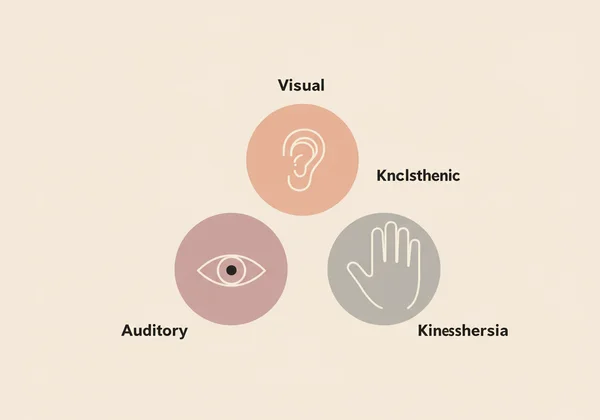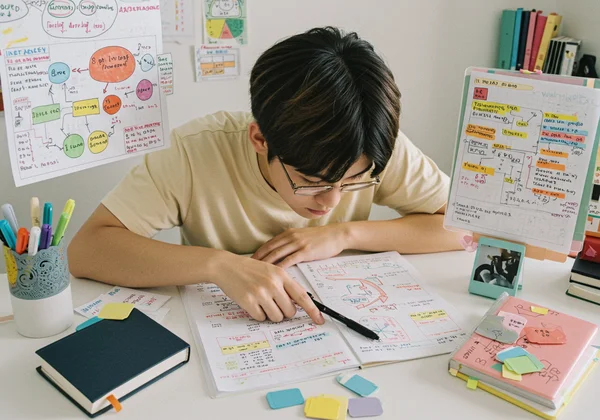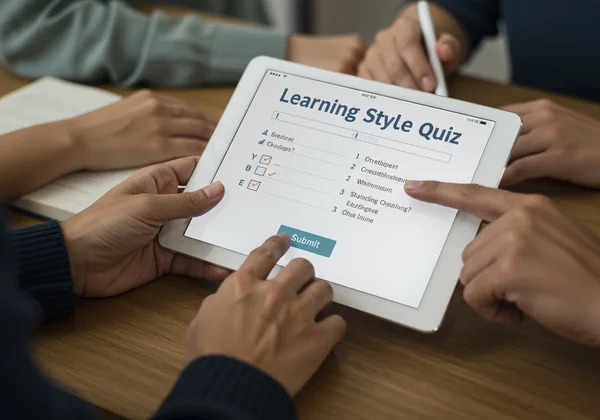VAK Learning Styles: Your Essential Learning Style Quiz Guide
Imagine learning feeling effortless, not like a chore. Ever wondered why some study methods just click, while others feel like a constant uphill battle? It might be because you haven't yet discovered how you learn best. This article will dive deep into the VAK learning styles (Visual, Auditory, Kinesthetic) – explaining what they are, how to spot them, and most importantly, why understanding your unique approach can transform your studies, teaching, or parenting, making learning genuinely enjoyable. Ready to pinpoint your primary learning preference? Take our quick free assessment now!
Understanding the VAK Model: A Foundation for Learning
The VAK model is a popular, simple framework for understanding how people prefer to take in information. It's a powerful tool to grasp how different individuals absorb, process, and remember new knowledge most effectively. This model, and others like it, are fundamental to helping people learn more effectively worldwide.

What is the VAK Learning Style Model?
The VAK model explained breaks down learning into three main sensory preferences: Visual, Auditory, and Kinesthetic. These represent the primary ways you might interact with and learn from your environment. While most of us use a mix of these styles, typically one or two will feel more natural or dominant. Spotting these tendencies is the crucial first step toward creating a learning environment that truly works for you.
Why Identifying Your Learning Style Matters
Knowing your dominant learning style isn't just an interesting tidbit – it's a game-changer for your learning journey and personal growth. Imagine how much easier studying could be if you knew exactly what clicked for your brain. For students, it means getting more out of their study time. Teachers can craft lessons that reach every student. Parents can genuinely help with homework, and professionals can pick up new skills faster. When you understand your own learning preferences, you're more engaged, you grasp concepts more easily, and you remember what you learn for longer. It's about making learning an active, personalized, and truly enjoyable experience, rather than just something that happens to you.
The Visual Learning Style: Seeing to Understand
For many, the world of information comes alive through images, charts, and diagrams. These individuals are often visual learners, preferring to process information that they can see.
Key Characteristics of a Visual Learner
Visual learners truly shine when they can see information. They often recall faces vividly but might struggle with names, and their minds often drift into daydreams filled with images. These individuals tend to be organized, meticulous, and naturally drawn to visual aids like maps, graphs, and flowcharts. When it's time to study, you might find them doodling, highlighting key points in various colors, or using color-coding to organize their notes. For visual learners, absorbing new material often comes down to one simple truth: seeing is understanding.
Strengths and Common Challenges for Visual Learners
One major strength of visual thinkers is their natural ability to quickly grasp spatial relationships and spot patterns. They excel at planning and often have sharp observational skills. On the flip side, environments lacking visual cues – like a purely lecture-based class or an audio-only presentation – can be challenging. They might also find it difficult to follow spoken directions without a visual to go along with them, which can sometimes lead to confusion.
Practical Learning Tips for Visual Thinkers
If you're a visual learner, try incorporating these strategies into your routine:
-
Grab flashcards, create vibrant mind maps, and use diagrams whenever possible.
-
Dive into educational videos and documentaries – let the visuals do the talking.
-
Stock up on highlighters and colored pens; use them to organize and emphasize notes.
-
Don't be afraid to draw pictures or create visual metaphors to untangle complex ideas.
-
In a classroom, choose a seat where you have a clear view of the instructor and any visual aids. These study methods are perfect for helping visual learners transform abstract concepts into tangible images they can easily remember.

The Auditory Learning Style: Hearing to Absorb
For some, learning truly clicks when they hear information. The rhythm of spoken words, lively discussions, and even background music can be their ideal pathway to knowledge – this is the hallmark of an auditory learning style.
Traits and Preferences of Auditory Learners
Auditory learners naturally soak up information through both listening and speaking. You might notice they easily recall names, and they might even enjoy having music on while they study. To help concepts stick, they often repeat information aloud, or they'll usually prefer lively discussions and debates over quiet, solitary reading. They thrive in group study environments where they can articulate their thoughts and hear different explanations. For auditory learners, good conversation isn't just nice – it's crucial for understanding and remembering.
Maximizing Learning Effectiveness for Auditory Learners
If you're an auditory learner, these strategies can supercharge your learning:
-
Record lectures (with permission!) and listen to them during your commute or while exercising.
-
Read your notes aloud, or better yet, explain complex concepts to a friend or even just to yourself.
-
Jump into discussions and study groups – your voice and ears are your best tools.
-
Create mnemonic devices, rhymes, or even short songs to help tricky facts stick.
-
Load up on podcasts, audiobooks, and the audio tracks of educational videos. By truly engaging their sense of hearing, auditory learners can dramatically boost how well they understand and recall information.

The Kinesthetic Learning Style: Learning by Doing
For those who truly learn by doing, touching, and moving, the kinesthetic learning style is often their superpower. These learners simply need to physically engage with the material to make it stick.
How Kinesthetic Learners Process Information
Kinesthetic learners are the ultimate hands-on learners. They thrive by doing, touching, and physically experiencing information. Think about how you learned to ride a bike – you didn't just read about it, you got on and pedaled. That's the kinesthetic spirit! They'll often recall what they did much more easily than what they merely saw or heard. These individuals might find it challenging to sit still for long stretches, often preferring to pace or move while processing information. They might use animated gestures when speaking, and they remember best when information is linked to a physical activity or a strong emotion. For them, learning is always an active, immersive adventure.
Engaging Strategies for Kinesthetic Learners
If you lean towards a kinesthetic style, these hands-on approaches are perfect for you:
-
Incorporate movement: Pace around while memorizing facts, or keep a fidget toy nearby to channel your energy.
-
Whenever possible, conduct experiments, build models, or engage in hands-on projects.
-
Don't sit still for too long! Take frequent, short breaks during study sessions to stretch, walk around, or even do a few jumping jacks.
-
Use role-playing or real-life scenarios to deeply understand concepts – make it tangible.
-
Write notes by hand, rather than typing. The physical act of writing helps to solidify learning.
-
Curious to confirm your style? Try a visual auditory kinesthetic test to see if this active approach truly resonates with you. These active learning techniques are key to helping kinesthetic learners forge strong connections between physical action and mental understanding.

Embracing Your Unique Mix: Beyond a Single Style
While the VAK model offers clear categories, it’s crucial to remember that human learning is wonderfully dynamic and complex. Very few people are purely one type of learner.
The Reality of Blended Learning Styles
Most of us actually have blended learning styles, meaning we tap into a mix of visual, auditory, and kinesthetic preferences. For example, you might love seeing diagrams (visual), but also find that discussing concepts aloud (auditory) really helps them sink in. Plus, your most effective style can even change depending on the subject, your energy levels, or simply as you get older. The aim isn't to stick a single label on yourself, but to understand your strongest learning preferences and how to make them work for you. This kind of self-awareness is what truly leads to more effective learning.
Steps to Discover Your Personal Learning Profile
Understanding your dominant learning preferences is a fantastic first step towards making learning work better for you. While this article has given you a peek into the VAK styles, the absolute best way to pinpoint your unique profile is with a quick, personalized assessment. That's why our platform offers a free learning style quiz that's fast, insightful, and doesn't even require registration. It’s designed to help you clearly identify your primary learning tendencies, giving you practical knowledge you can put to use right away. Curious to see what you discover? Discover your style today!

Discover Your Learning Style: Your Path to Smarter Learning
Understanding your VAK learning styles can truly transform how you learn, work, and grow. Whether you're a student aiming for better grades, a teacher creating more inclusive lessons, a parent eager to support your child, or a professional looking to master new skills efficiently, knowing your unique learning preference can make a world of difference. This self-awareness allows you to confidently choose the most effective study methods and learning environments for yourself.
Ready to make learning work for you instead of against you? It’s easier than you think to find your rhythm. Our quick, free learning style quiz for adults and students alike offers personalized insights, without any sign-up needed. Discover how you can learn smarter, starting today, and finally answer "what is my learning style quiz?" Find your style and stop learning harder, start learning smarter!
Frequently Asked Questions About Learning Styles
Are there more than three learning styles, like 4 or 7?
Yes, absolutely! While the VAK model (Visual, Auditory, Kinesthetic) is incredibly popular and easy to grasp, many other models exist that propose even more styles. For instance, the VARK model expands on VAK by adding "Read/Write" as a fourth preference, and grander theories like Gardner's Multiple Intelligences suggest many more distinct ways of learning. Our quiz hones in on the core VAK elements because they offer accessible, actionable insights, providing a robust foundation for understanding how to identify your learning style.
How do learning styles differ from learning disabilities?
This is a really important distinction! Learning styles are all about your preferred way of taking in information; they are preferences, not indicators of ability or any kind of deficit. A learning style quiz helps you discover these personal preferences. Learning disabilities, conversely, are neurological conditions that impact the brain's ability to receive, process, analyze, or store information, often making learning challenging regardless of the method used. Our quiz is here to help you understand your learning preferences, never to diagnose disabilities.
Can your dominant learning style change over time?
Yes, absolutely! Your dominant learning style quiz for kids or adults can definitely evolve throughout your life. As you gain more experience, dive into new subjects, or pick up new skills, your preferences might naturally shift or expand. For example, someone who was a primarily kinesthetic learner as a child might find themselves developing stronger visual or auditory preferences later on, simply through exposure to different learning techniques or technologies. It's actually a great idea to regularly re-evaluate your style to keep your learning optimized.
How can I improve my study habits based on my learning style?
Once you've taken a learning style quiz, you're perfectly positioned to fine-tune your study habits to match your natural strengths. If you discover you're a visual learner, start integrating more diagrams, charts, and visual outlines. If you're auditory, consider listening to podcasts or audiobooks related to your subject. And for kinesthetic learners, remember to build in movement or hands-on activities. Our platform goes a step further, providing personalized strategies and suggestions based on your specific results, helping you apply these insights directly to your studies. This is precisely what makes the learning style quiz for students such an incredibly valuable tool.